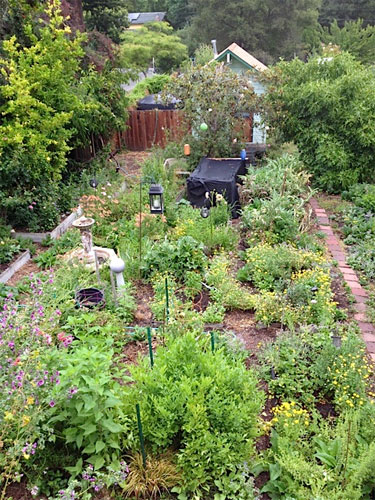I think climate change is affecting my garden in Ben Lomond, California (a section of which shown at right). It is situated along a narrow strip in the Santa Cruz Mountains which lie some 2,500 feet above sea level and in close proximity to the San Lorenzo River watershed.
We’ve lived in this same spot where we raised our family for 30 years. For all those years, I indulged my gardening passion. I noticed that while my friends in Santa Cruz mightily contended with gophers in their gardens, the rodents never were a problem for me. Eventually I realized that our high, ground-level water table made an environment inhospitable to gophers.
Then things began to change within the last four or five years: advancing climate change and increased dryness brought the first signs of mole and gopher depredation. It is further added to by the fact that as my neighbors go the route of building wire cages around their fruit trees and planting boxes, it seems that their gopher problem is importing itself into my yard.
But so far, the situation is still manageable. The problem seems to be controlled by the fact that I don’t make it easy for underground critters to set up residence under a pure patch of carrots, corn, broccoli or some other gopher-delectable item. Overplanting too many different things too close seems to be both a virtue as well as a problem with my ‘jungle-styled’ gardening. I tend to have a diversity of vegetables, flowers and what I imagine to be non-delectable herbs growing all together. This happens to be a virtue in terms of controlling a variety of underground pests but not sufficiently thinning to allow for maximum yield and size can also be a problem, which I haven’t yet been able to reconcile with denser, diverse planting.
The second sign of climate change has been the lack of sufficient consecutive sunny, hot growing days. The flavor and sweetness that we enjoy in plants is the taste of sunlight – biochemically transposed into plants. If the weather is inconsistent as it has been (in my opinion because of variable jet stream patterns), the effect on my favorite strawberry patch has been a single modest yield and prolonged dormancy. Tomatoes tend to stay green on the plant too long and when they ripen are less sweet; corn may not ripen at all or yield partially filled ears. The honeysuckle blossoms, which are usually in full bloom by the end of June, have barely opened.
The lack of rainfall has caused a corresponding increase of pollens in the air, making this a particularly bad year for allergies. I’m sure there are many other effects that I haven’t definitively recognized. My small garden nestled in the mountains of Ben Lomond can only join with the ‘non-alleluia’ chorus of humanity around the world, at the mercy of the forces of unrelenting greed to say, “Where is it all leading, when will it ever end?”
Evidently by the sign of things, not anytime soon. With all of this quiet panic in the garden, I read how the US is finding more available oil from fracking and other previously untapped sources. The once lesser populated state of Wyoming is experiencing an oil boom compared to the 1849 Gold Rush in the mountains of California. As in California, this has the potential of wreaking devastation on the pristine nature of the surrounding open-sky plains and rivers.
An article published by Earth Justice says:
Thanks to a drilling boom, air quality on the plains of Wyoming is now worse than the car-choked megalopolis of Los Angeles. In the drilling rig-studded Upper Green River Basin, levels of ozone – the main component of smog – have reached 124 parts per billion – well over the federal safety standard and worse than the worst day in Los Angeles in 2010. There are some bright spots, though: in 2010, the Wyoming Oil & Gas Conservation Commission passed some of the strongest rules in the country requiring oil and gas companies to disclose the secret chemicals they use in fracking – a big step forward for the state and leading the way for reform at the national level.
I have deep misgivings as to what such a disturbance of “The Peace of Wild Things” (referring to the famous poem by Wendell Berry) means to the world, its rivers, plains, forests, plants, creatures, and how what has occurred has already impacted my garden.


love all ur posts Michael!